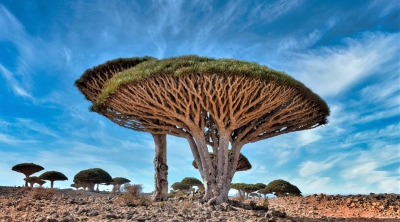
Hosting hundreds of plant and animals species that are found nowhere in the world, it’s small wonder that Yemen’s Socotra archipelago has been called the Galapagos of the Indian Ocean.
Full of life!
Located more than 300 km from its parent country Yemen, the Socotra archipelago comprises four islands in the Indian Ocean between Somalia and Yemen. Covering a total area of nearly 4,000 sq.km., the islands are known for their rich biodiversity and unique flora and fauna. For instance, among the 825 plant species found in the region now, as many as 307 cannot be seen anywhere else in the world. Birds such as the Socotra starling, Socotra sunbird, and Socotra warbler are said to be found only here. A staggering 90% of reptile species and 95% of land snails too are said to be endemic (found nowhere else). Because of this, the place is often referred to as the “Galapagos of the Indian Ocean”.
Lying close as it does to the African continent, the archipelago appears to be the extension of the Horn of Africa. About 20 million years ago, these islands were believed to have broken off the Gondwana supercontinent. The archipelago was declared a UNESCO World Heritage Site with “Outstanding Universal Value” in 2008. Though the habitats within the region appear to be healthy and safe, they are not without threat. These include tourism, invasive species, overusing of natural resources and natural disasters. In fact, the conservation outlook for this site has been assessed as “significant concern” in the latest assessment cycle 2020.
Wildlife
Nearly 200 species of birds, including land and sea, are said to be seen in the archipelago. Among them are garganeys, shovelers, pintails, teals, ducks, guinea fowls, quails, flamingoes, grebes, pigeons, doves, sandgrouses, coucals, nightjars, swifts, moorhens, stilts, plovers, stints, snipes, sandpipers, coursers, gulls, terns, tropicbirds, petrels, shearwaters, boobies, egrets, herons, ibises, ospreys, buzzards, owls, hoopoes, bee-eaters, falcons, shrikes, ravens, larks, martins, swallows, warblers, whitethroats, thrushes, wheatears, starlings, sunbirds, pipits, wagtails, buntings, and sparrows. As an archipelago, the region has a startling variety of corals, fishes, crabs, lobsters, and shrimps too, together adding up to more than 1,000 species!
Dragon’s blood tree
Synonymous with the identity of Socotra, the dragon’s blood tree is found nowhere else in the world. It “lives within remnants of prehistoric ‘Dragonsblood forest on granite mountains and limestone plateaus” within Socotra.
Marked by a unique umbrella-shaped canopy, the tree is said to capture the moisture in the air through its leaves and take it to the roots. Having held an economically significant role for centuries, the tree has varied uses. When fed to cattle in very small quantities, the tree’s berries are said to improve the animals’ health.
The tree gets its name from the red-coloured resin it produces, and this resin is believed to have several medicinal uses. The International Union for Conservation of Nature’s conservation status for the tree is “vulnerable”.. Shockingly, it has been discovered that hardly any “populations are regenerating naturally”. In addition, it has been noticed that “in some areas young trees lack the species’ characteristic umbrella shape”.
As climate change intensifies, “Socotra is drying out, with once reliable monsoon weather becoming patchy and irregular. And this could spell irreversible change to the archipelago and its unique inhabitants.
Picture Credit : Google



